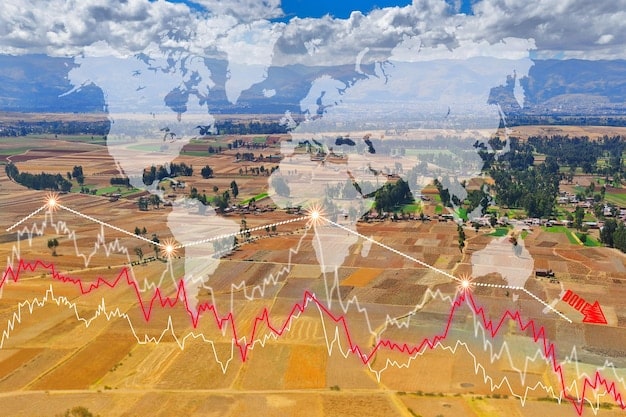China’s Economic Slowdown and US Agricultural Exports: Diversification Strategies

China’s economic deceleration significantly impacts US agricultural exports, necessitating diversification strategies to mitigate risks and maintain market access.
The recent slowdown in China’s economic growth presents a considerable challenge for US agricultural exporters. Understanding the impact of China’s economic slowdown on US agricultural exports: strategies for diversification is crucial for ensuring the stability and growth of the US agricultural sector in the face of changing global economic dynamics. China has been a major importer of U.S. agricultural products, making the U.S. highly vulnerable to any shift in China’s financial and economic performance.
Understanding China’s Economic Slowdown
China’s economic trajectory has shifted from rapid expansion to a more moderate pace. This deceleration is driven by a combination of factors, including structural reforms, demographic changes, and global economic headwinds. Understanding these drivers is crucial for anticipating their impact on US agricultural exports.
Key Factors Contributing to the Slowdown
Several factors are contributing to China’s economic slowdown. These include adjustments to its industrial and export-oriented economic model and efforts to foster domestic demand and technological innovation. A deeper dive into these specifics provides context for the potential impact on international trade.
- Decreasing domestic demand due to a shift in consumer spending habits.
- Government regulations and industrial policy adjustments affect key sectors.
- Geopolitical tensions impact trade and investment flows.
- Real estate market corrections reducing investment and construction activities.
The slowdown in China’s economy is not just a cyclical downturn. It reflects underlying structural issues and policy changes that will likely have long-term consequences for the global economy.
The Direct Impact on US Agricultural Exports
Given China’s significance as a major importer of agricultural goods, any slowing of its economic growth inevitably affects U.S. farm exports. Various mechanisms, from supply and demand responses to modifications in trade regulations, shape that impact.

Specific Commodities Affected
The impact of China’s economic slowdown is not uniform across all U.S. agricultural commodities. Certain sectors, such as soybeans, corn, and pork, are more heavily reliant on the Chinese market and therefore more susceptible to changes in demand. A look at the specifics is helpful to fully grasp the effects.
- Soybeans: Reduced demand affects prices and export volumes.
- Corn: Decreased livestock production lowers corn imports.
- Pork: Changes in consumer preferences and domestic production affect pork exports.
- Dairy: Lower consumer-driven demand reduces dairy product exports.
China’s economic slowdown has a clear and direct effect on the volume and value of U.S. agricultural exports, compelling producers and policymakers to revise trade strategies.
Diversification Strategies for US Exporters
To mitigate the risks associated with relying on a single market, such as China, US agricultural exporters should actively pursue diversification tactics. This strategy involves identifying and capitalizing on opportunities in other growing global markets.
Exploring Alternative Markets
Identifying and developing relationships with other countries is crucial for mitigating the risks of relying too heavily on the Chinese market. Vietnam, Indonesia, and India represent growing markets.
Expanding into new markets requires a comprehensive approach that includes market research, relationship building, and adapting products to meet local tastes and regulations.
Developing Value-Added Products
Shifting from exporting raw commodities to value-added products can enhance competitiveness and resilience. These products offer higher margins and are often less sensitive to fluctuations in demand.
Investing in processing infrastructure and technologies can enable producers to transform raw commodities into value-added products, opening up new opportunities.
Policy and Government Support
Government programs and policies could play a vital role in helping US agricultural exporters diversify their markets and adapt to changing global economic dynamics. These initiatives might lower the difficulty and financial risks associated with expanding overseas.

Trade Agreements and Negotiations
Pursuing new trade agreements and strengthening existing ones can help open doors to new markets and reduce trade barriers. These agreements can provide preferential access for U.S. agricultural products, enhancing their competitiveness.
- Negotiating favorable terms with key trading partners.
- Reducing tariffs and non-tariff barriers.
- Ensuring fair competition in international markets.
Trade agreements provide a framework for predictable and stable trade relations, helping to reduce uncertainty and encourage investment.
Financial Assistance and Export Promotion
Government-backed financial assistance and export promotion programs can help US agricultural exporters overcome financial hurdles. These programs can provide access to credit, insurance, and marketing support, enabling them to compete more effectively.
With government resources, American agricultural exporters can strengthen abilities, and expand international influence, to diversify markets adeptly.
Technological Innovation and Adaptation
Adopting technological innovation and adapting production practices are also critical for navigating China’s economic slowdown. These advancements can improve productivity, lower costs, and enhance the quality and sustainability of U.S. agricultural products.
Precision Agriculture and Data Analytics
Employing precision agriculture techniques and data analytics can optimize resource use, reduce waste, and increase yields. These technologies enable farmers to make informed decisions about planting, irrigation, and fertilization, improving efficiency and profitability.
Farmers can increase performance with smart use of data-driven insights into soil conditions, weather patterns, and crop health, so as to navigate the economic slowdown.
Sustainable Farming Practices
Embracing sustainable farming practices can enhance the long-term viability of U.S. agriculture and appeal to environmentally conscious consumers in global markets. These practices can reduce the environmental impact of farming, conserve resources, and improve soil health.
Sustainable agricultural techniques are an avenue to economic resilience, and increase production output alongside increasing demand for American products in global export markets.
Case Studies: Success Stories in Diversification
Examining success stories of US agricultural exporters that have effectively diversified their markets can provide valuable insights and guidance for others seeking to do the same. These case studies highlight the strategies, challenges, and outcomes of diversification efforts.
Learning from these examples might ease potential risks of international market fluctuation, and potentially identify profitable international markets to shift reliance from one source.
Successful diversification involves a combination of careful planning, effective execution, and adaptability. By learning from the experiences of others, US agricultural exporters can increase their chances of success in navigating the challenges posed by China’s economic slowdown.
| Key Point | Brief Description |
|---|---|
| 📉 China’s Slowdown | Economic deceleration impacts US agricultural exports. |
| 🌍 Diversification | Explore new markets to reduce reliance on China. |
| 🌾 Value-Addition | Shift to value-added products for higher margins. |
| 🤝 Government Support | Seek government support for export promotion. |
How does China’s economic slowdown affect US agricultural exports?
▼
The main impacts include reduced demand for US agricultural products, lower export volumes, price drops for key commodities like soybeans and corn, and a shift towards alternative markets by US exporters.
▼
Soybeans, corn, pork, and dairy products are among the most vulnerable due to their high export volumes to China. Any reduction in China’s import capacity directly impacts these sectors.
▼
US exporters can explore alternative markets like Vietnam and Indonesia, develop value-added products, participate in government export promotion programs, and embrace technological innovation in agriculture.
▼
The US government can negotiate favorable trade agreements, reduce tariffs and non-tariff barriers, offer financial assistance and insurance, and provide marketing support to help exporters enter new markets.
▼
Technology, specifically precision agriculture and data analytics, can optimize resource use, increase yields, reduce waste, and enhance the sustainability of US agricultural practices, making exports more competitive.
Conclusion
Navigating the complexities of China’s economic deceleration necessitates a multi-faceted strategy for US agricultural exporters. By embracing diversification, leveraging policy support, and adopting innovative technologies, U.S farmers can maintain economic resilience.





